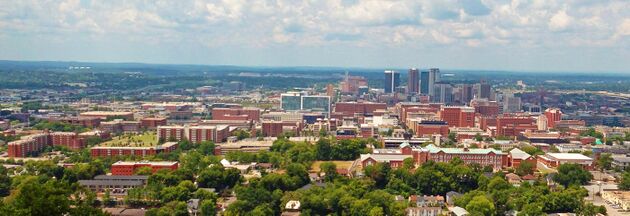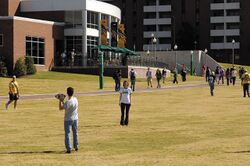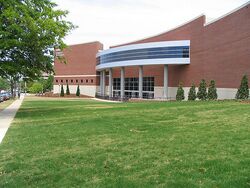University of Alabama at Birmingham
Topic: Organization
 From HandWiki - Reading time: 18 min
From HandWiki - Reading time: 18 min
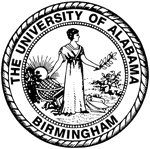 | |
Former name | Medical College of Alabama (1859–1966) Birmingham Extension Center (1936–1966) College of General Studies (1966) The University of Alabama in Birmingham (1966–1969) |
|---|---|
| Type | Public research university |
| Established | June 16, 1969 |
Parent institution | University of Alabama System |
Academic affiliation |
|
| Endowment | $711.6 million[1] |
| Budget | $4.34 billion (2021)[2] |
| President | Ray L. Watts |
| Provost | Pam Benoit |
Academic staff | 3,096[3] |
| Students | 22,563[4] |
| Undergraduates | 13,836 |
| Postgraduates | 8,087 |
| Location | Birmingham , Alabama , United States [ ⚑ ] : 33°30′07″N 86°48′28″W / 33.5020°N 86.8079°W |
| Campus | Midsize city |
| Newspaper | The Kaleidoscope |
| |u}}rs | Green and gold[5] |
| Nickname | Blazers |
Sporting affiliations |
|
| Mascot | Blaze the Dragon |
| Website | www |
The University of Alabama at Birmingham (UAB) is a public research university in Birmingham, Alabama. Founded in 1969 in the University of Alabama System, UAB has grown to be the state's largest single employer, with more than 24,200 faculty and staff and over 53,000 jobs at the university and in the health system. The university is classified among "R1: Doctoral Universities – Very high research activity".[7]
UAB offers 140 programs of study in 12 academic divisions leading to bachelor's, master's, doctoral, and professional degrees in the liberal arts, humanities, mathematics, social, behavioral, natural and physical sciences, business, education, engineering, and health-related fields such as medicine, dentistry, optometry, nursing, and public health.[8] In the fall of 2020, 22,563 students from more than 110 countries were enrolled.[9]
The UAB Health System, one of the largest academic medical centers in the United States, is affiliated with the university. UAB Hospital sponsors residency programs in medical specialties, including internal medicine, neurology, physical medicine and rehabilitation, surgery, radiology, and anesthesiology.
History
In 1936, in response to the rapid growth of the Birmingham metropolitan area and the need for the population to have access to a university education, the University of Alabama established the Birmingham Extension Center.[10] The center operated in an old house in downtown Birmingham at 2131 6th Avenue North and enrolled 116 students. In 1945, UA's newly established four-year School of Medicine moved from Tuscaloosa to Birmingham and took over management of Jefferson and Hillman hospitals. In 1957 enrollment at the extension center stood at 1,856. By 1959, research grants, training grants, and fellowships exceeded $1 million, and ground was broken for a new Children's Hospital.
By the 1960s, it grew apparent that the extension center was becoming a university in its own right. An engineering building was built close to the medical center in 1962. In September 1966, the Extension Center was renamed the College of General Studies and elevated to a full four-year program. That November, the College of General Studies and the School of Medicine were merged into the University of Alabama in Birmingham, with Dr. Joseph Volker as "Vice President for Birmingham Affairs"–reflecting that it was still treated as an offsite department of the main campus in Tuscaloosa. An Advisory Board for UAB was created in 1967. In 1969, the legislature created the University of Alabama System. UAB became one of three four-year institutions within the new system, which also included UA and the University of Alabama in Huntsville (UAH) in Huntsville. Volker became UAB's first president.[10]
In the 1970s, the university began a period of rapid growth. Enrollment at the beginning of the decade stood at 6,629, including 2,724 women. To accommodate the growing student population, UAB acquired land in the Southside. UAB Mini Park (the predecessor to The UAB Green) was dedicated in 1977.
The university created an intercollegiate athletic program, joined the NCAA and began fielding teams beginning with golf in 1970 and men's basketball in 1978. The university's name was changed to the University of Alabama at Birmingham in 1984, simply exchanging the preposition "In" for "at."
Presidents of UAB
- Joseph F. Volker, 1966–1976 (titled as VP for Birmingham Affairs, 1966–1969)[10]
- S. Richardson Hill Jr., 1977–1987
- Charles A. McCallum, 1987–1993
- J. Claude Bennett, 1993–1996
- Paul Hardin, 1997 (interim)
- W. Ann Reynolds, 1997–2002
- Carol Garrison, 2002–2012
- Ray L. Watts, 2013–present
Campus
UAB is located in the Southside neighborhood of downtown Birmingham. Occupying more than 100 city blocks,[11] the roughly rectangular campus blends with the urban character of the Southside, stretching between 4th Ave S and 12th Ave S north to south and 8th St and 22nd St east to west. University Boulevard serves as the main axis of the rectangle and Campus Green sits approximately at the center.
The campus can be divided into three sections. The medical center occupies most of the campus east of Campus Green. The medical center is home to the health science schools and their teaching facilities, including the UAB Health System (UABHS). The medical center overlaps with the larger Birmingham Medical District where, in addition to UABHS, non-UAB affiliated hospitals such as the VA Medical Center Birmingham, Children's Hospital of Alabama and Cooper Green Mercy Hospital are located.
The academic heart of campus stretches from the Campus Green west and from University Boulevard south. Campus Green, developed between 2000 and 2007 as part of the move to convert the school from its previously commuter school feel into a more traditional residential campus, not only anchors the academic campus but serves as the centerpiece for the university as a whole. Most academics and arts buildings (excluding those associated with the medical center), residence halls, and student life facilities sit on or within two blocks of the Green.
Athletics facilities, including Bartow Arena and PNC Field are located on the far western side of campus.
Since 1969, UAB has undergone extensive growth and construction projects are common across campus. Projects that are in planning, recently completed, or under construction include:[12]
- Collat School of Business and Bill L. Harbert Institute for Innovation and Entrepreneurship, ribbon cutting on August 28, 2019.[13]
- Police and Public Safety Headquarters, ribbon cutting on August 9, 2018.[14]
- School of Nursing, ribbon cutting on September 6, 2018.[15]
- College of Arts & Sciences University Hall - the first LEED-certified building on UAB campus - ribbon cutting on September, 2019.[16]
Organization and administration
| Academic Divisions of UAB | |
|---|---|
| College/school | Year founded[17] |
| College of Arts and Sciences | 2010 |
| School of Business | 1971 |
| School of Dentistry | 1945 |
| School of Education | 1971 |
| School of Engineering | 1971 |
| School of Health Professions | 1969 |
| School of Medicine | 1945 |
| School of Nursing | 1967 |
| School of Optometry | 1969 |
| School of Public Health | 1981 |
| Honors College | 2012 |
| Graduate School | 1970 |
UAB is an autonomous institution within the University of Alabama System, which is governed by the Board of Trustees of the University of Alabama and headed by Chancellor of the University of Alabama. The board is self-nominating and composed of 15 elected members and two ex officio members. The makeup of the board is dictated by the Constitution of the State of Alabama, and requires that the board be made up of three members from the congressional district that contains the Tuscaloosa campus, and two members from every other congressional district in Alabama. Board members are elected by the board and are confirmed by the Alabama State Senate. Board members may serve three consecutive six-year terms.[18]
The president of the University of Alabama at Birmingham is the principal executive officer of the university and is appointed by the chancellor with approval of the board of trustees. The president reports directly to the chancellor, and is responsible for the daily operations of the university. The president also acts as chairman of the board of the UAB Health System.[19] Richard Marchase was named interim president on August 21, 2012, after the retirement of former president Carol Garrison.[20][21][22][23] In February 2013, Ray L. Watts became UAB's seventh president.[24]
Colleges
UAB is composed of one college, nine schools and the Graduate School. Together, these divisions offer 56 bachelor's degree programs, 59 master's degree programs, and 40 doctoral programs.[25]
Before 2010, the schools of Arts and Humanities, Social and Behavioral Sciences, Natural Science and Mathematics, and Education were separate, degree-granting units within the university. The schools were merged into a single college (the first at UAB): the College of Arts and Sciences, with Education retaining its identity as a distinct unit within the new college. University leaders cited efficiency, curricula, and more opportunity for interdisciplinary research and cooperation for the restructuring.[26]
Endowment
UAB's endowment stood at $711.6 million in 2021.[27] UAB received more than $715 million in research grants and extramural awards for FY 2022.[28]
In 1999, the university launched a capital campaign with a goal of $250 million. When it ended in 2003, the UAB Capital Campaign had raised over $388.7 million.
The Campaign for UAB launched publicly in October 2013 with a goal of raising $1 billion. Prior to the public launch of the campaign, UAB had already received over $420 million in donations.[29] In 2018, UAB exceeded the $1 billion goal of The Campaign for UAB, the most ambitious fundraising effort in the university's history. Putting the Campaign over its goal was the largest single gift ever made to UAB: $30 million from O’Neal Industries and its shareholders to name the O’Neal Comprehensive Cancer Center at UAB.[30][31]
Academics
| - | Alabama resident | Non-resident |
|---|---|---|
| Undergraduate (2 x 15cr) | $10,710 | $25,500 |
| Graduate (2 x 12cr) | $8,100 | $24,534 |
| Optometry (yr) | $9,286 | $18,004 |
| Dentistry (yr) | $14,891 | $34,710 |
| Medicine (yr) | $29,998 | $62,714 |
UAB is a large, four-year research university and is classified among "R1: Doctoral Universities – Very high research activity".[33] UAB has been accredited by the Southern Association of Colleges and Schools since 1970, according to the U.S. Department of Education.[34] Undergraduates comprise a majority of the total university enrollment. Part-time and transfer student comprise a sizable portion of the undergraduate student body. The undergraduate instructional program provides a balance between professional programs of study and the liberal arts (meaning the number of degrees awarded in the two areas is similar), and there is a high level of co-existence between the graduate and undergraduate programs (meaning that the majority of undergraduate program have graduate degree program counterparts). The university has a high level of research activity and has a graduate instructional program emphasizing doctorates in STEM fields as well as professional programs in the health and veterinary sciences.
The academic calendar is based on the semester system, which divides the academic year, lasting from mid-August to early May, into two 15-week semesters (fall and spring) and the summer. The fall semester ends in early December and the spring term begins in early January. The summer, which lasts from mid-May to August, is divided into a number of sessions: a 12-week session, a 3-week "mini-semester" in May, a nine-week session in June and July, and two four-week sessions in June and July, respectively.[35] The schools of medicine and dentistry follow an academic calendar beginning in July and ending in late May/early June.[36][37]
In academic year 2016–2017, UAB awarded in a total 2,384 bachelor's degrees; 1,795 master's degrees, 33 educational specialist degrees; 125 research doctorates; and 391 professional doctorates.[38]
Student profile
In fall semester 2018, the UAB student body consisted of 13,836 undergraduates, 6,933 graduate students and 1,154 professional doctoral students from all 67 Alabama counties, all 50 states and more than 110 foreign countries. In fall semester 2018, 5,737 students were enrolled in the College of Arts and Sciences, 3,432 in Business, 2,736 in Nursing, 2,431 in Health Professions, 1,775 in Education, 1,486 in Engineering, 752 in Public Health, 694 in Medicine, 324 in Joint Health Sciences, 271 in Dentistry, 217 in Optometry, and an additional 1,902 who were undecided.
Of the undergraduate student body, 33.2% are from Jefferson County, 14.4% are from other counties in the Birmingham metropolitan area, specifically Blount, Shelby, St. Clair and Walker counties. 29.4% come from the rest of Alabama, 18.2% from the rest of the United States, while international students comprise 4.8%. The male-to-female ratio among undergraduates is 2:3. Reflecting one of the core reasons for UAB's founding, a large percentage of undergraduates are from non-traditional demographics. 27.4% of undergraduates are part-time students, and 18.7% are above the age of 25. (The average undergraduate is 23 years old.)[39]
The undergraduate student body was 56% non-Hispanic white, 26% Black/African-American, 6% Asian, 5% two or more races, 3% Hispanic, and 3% International.[40]
Faculty and staff
UAB has 24,259 employees, 12,913 in the university, including 3,096 faculty, and 11,346 in the UAB Health System.[41] 91.3% of the faculty at UAB hold an academic or professional doctorate. Eight faculty members from UAB have been elected to the National Institute of Medicine.[42] The student-faculty ratio at UAB is 18:1.
Library
UAB has eight library locations: Mervyn H. Sterne Library, Lister Hill Library of the Health Sciences, Lister Hill Library at University Hospital, Reynolds-Finley Historical Library, Alabama Museum of the Health Sciences, UAB Archives, UAB Digital Collections, and the 801 Building.[43] Sterne Library holds 1.7 million print volumes while Lister Hill Library holds a little under 350,000.[17]
| University rankings | |
|---|---|
| National | |
| Forbes[44] | 307 |
| THE/WSJ[45] | 256 |
| U.S. News & World Report[46] | 137 |
| Washington Monthly[47] | 196 |
| Global | |
| ARWU[48] | 301-400 |
| THE[49] | 169 |
| U.S. News & World Report[50] | 147 |
Rankings
|
USNWR graduate school rankings[51] | |
|---|---|
| Business: Part-Time MBA | 89 |
| Education | 99 |
| Engineering | 112 |
| Medical: Primary Care | 24 |
| Medical: Research | 35 |
| Nursing: Doctorate | 13 |
| Nursing: Master's | 10 |
|
USNWR departmental rankings[51] | |
|---|---|
| Biological Sciences | 74 |
| Biostatistics | 19 |
| Chemistry | 122 |
| Clinical Psychology | 70 |
| Computer Science | 120 |
| Epiodemiology | 17 |
| Health Care Management | 1 |
| Health Policy Management | 15 |
| Mathematics | 117 |
| Nursing: Anesthesia | 65 |
| Occupational Therapy | 23 |
| Physical Therapy | 13 |
| Physician Assistant | 8 |
| Physics | 124 |
| Psychology | 97 |
| Public Affairs | 67 |
| Public Health | 19 |
| Sociology | 84 |
| Statistics | 89 |
In the 2022 U.S. News & World Report rankings, UAB was tied for the 137th best national university and was ranked tied for the 64th best public university.[52] The UAB Master of Science in Health Administration program is the top ranked Health Care Management program in the U.S. News & World Report rankings and the No. 1 program at UAB. Since 2015, the MSHA program has been the highest-ranking program at UAB.[53] In 2023, Fortune ranked the UAB's in-person master's degree in cybersecurity offered by the Department of Computer Science as the No. 1 program in the country.[54]
In 2018, UAB was named the Top Young University in the U.S. (50 years or younger) and among the top 10 globally in the Times Higher Education World University Rankings, which ranks effectiveness in areas such as teaching, research, citations, international outlooks and industry outcomes.[55]
Student life
| Race and ethnicity[56] | Total | ||
|---|---|---|---|
| White | 55% | ||
| Black | 24% | ||
| Asian | 7% | ||
| Hispanic | 6% | ||
| Other[lower-alpha 1] | 6% | ||
| Foreign national | 2% | ||
| Economic diversity | |||
| Low-income[lower-alpha 2] | 37% | ||
| Affluent[lower-alpha 3] | 63% | ||
There are over 300 student organizations on the UAB campus.
The UAB Model Arab League team is among the best government model teams in the nation with over five years of expansion and award-winning achievement including multiple "outstanding delegation" awards. The UAB Mock Trial team is consistently among the nation's best as a perennial Top 25 program. The program enjoyed its greatest success in 2006, when the team won the national title in the Silver Division defeating the defending national champions of Harvard University.
Recreation Center
Opened in 2005, the UAB Recreation Center serves the students, faculty, and alumni of UAB as well as the Birmingham community. The 150,000 square feet (14,000 m2) covers three floors: housing four basketball/volleyball courts, four racquetball courts (one of which can be converted to squash and four for wallyball), four aerobics studios, 18,000 square feet (1,700 m2) of weight and cardio-fitness areas, game room, KidsZone, aquatics center with both lap and leisure components, CenterCourt gym used for indoor soccer, floor hockey and badminton, juice bar, indoor track, and a climbing wall. The center includes free weights, court sports, swimming pools, group fitness classes, nutrition education, fitness areas, and a climbing wall.
Greek life
About six percent of undergraduate men and eight percent of undergraduate women are active in UAB's Greek system.[57] Twenty-two Greek Letter Organization (GLOs) are active on campus. Four governing bodies oversee the operations of university-sanctioned GLOs. These bodies act as umbrella organizations over the member GLOs. Among the differences between the governing bodies, the most important distinction are recruitment process and policies.
Student media
UAB Student Media is the home of the University of Alabama at Birmingham's student-run media outlets. They include Kaleidoscope, an award-winning weekly newspaper; BlazeRadio, a 24-hour online radio station live on the TuneIn app; Aura Literary Arts Review, a twice-yearly student magazine featuring fiction, creative non-fiction, art, photography, poetry and reviews; and UABTV, original, web-based video programming. UAB students operate all media. The articles, posts, newscasts and opinions are solely those of its student writers, producers, editors, deejays, etc. and do not reflect that of the university, its administrators or the Student Media advisors.[58]
Intramurals
The school has an intramural program that runs year-round. Students and staff compete for league trophies in sports such as basketball, bowling, flag football, golf, soccer, softball, ultimate frisbee, and volleyball, or play in tournaments in billiards, racquetball, tennis, and other sports.
On August 29, 2018, UAB held a ribbon-cutting ceremony for an Intramural Complex, located at 1101 Fifth Ave. South, that is home for the university's intramural outdoor sports and club sports. The complex is a joint project between UAB Student Affairs and Campus Recreation through the UAB Facilities Division. Campus Recreation will oversee the fields, as well as program and schedule them. The space includes two full-size competition fields, two digital scoreboards, access to water and campus Wi-Fi, and a utility building that includes two all-gender restrooms, a storage space for sports equipment, and a utility room for lights and power.[59]
Health system
The UAB Health System (UABHS) is a partnership between UAB and the University of Alabama Health Services Foundation (UAHSF), a private not-for-profit medical practice made up of the faculty of the UAB School of Medicine. UABHS is governed by a board of directors which has representatives of UAHSF, the University of Alabama Board of Trustees, and UAB administrators. The UAB president is the ex officio chairperson of the UAB Health System. The CEO of the UABHS reports directly to the UAB Health System board and is appointed by the chairman of the board.
UAB Hospital is the central institution of UABHS. It was formed as University Hospital in 1945 from the merger of Jefferson Hospital and Hillman Hospital, two private hospitals in the Southside of Birmingham acquired by the University of Alabama Board of Trustees. University Hospital was created to serve as the primary teaching hospital for the School of Medicine.
The other major institutions of UABHS include:
- The Kirklin Clinic of UAB Hospital, an outpatient clinic of UAB Hospital
- UAB Callahan Eye Hospital & Clinics, founded independently as the Eye Foundation Hospital in 1963 and merged into UABHS in 1973,[60]
- UAB Medicine Women and Infants Center
- UAB Hospital-Highlands. Formerly HealthSouth's flagship medical center in the Southside, UABHS acquired it in 2006. Highlands now serves as an acute care hospital. In 2011, Highlands was merged completely into UAB Hospital.
- Spain Rehabilitation Center
- UAB Medicine Health Centers, clinics operated and staffed by UABHS located throughout central Alabama
- Viva Health, a health maintenance organization (HMO) which is a subsidiary of Triton Health Systems, a limited liability corporation based in Birmingham and owned by the UABHS
In addition UABHS manages, but does not operate, Medical West in Bessemer and Baptist Health in Montgomery. UABHS also has affiliations with the Birmingham VA Medical Center, Children's Hospital of Alabama, and Huntsville Hospital in Huntsville.
Athletics
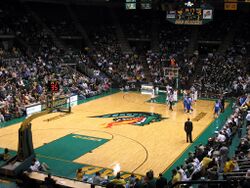
UAB's athletic teams are known as the Blazers. The school athletic colors are forest green and old gold.[61] The school currently participates in NCAA Division I, as a member of the American Athletic Conference since 2023.[62] The men's basketball team, coached by Andy Kennedy, plays in 8,508-seat Bartow Arena.
The school started its intercollegiate athletic program in 1978.[17] The program was inaugurated with men's basketball by Gene Bartow, who was John Wooden's successor at UCLA. Bartow left UCLA after several exceptional seasons (52–9 over three seasons, including a berth in the Final Four in 1976) to head up the founding of the first UAB men's basketball team. He served as the school's first head basketball coach and athletic director for 18 years. Bartow led UAB to the NIT in the program's second year of existence and followed that with seven straight NCAA Tournament appearances, including trips to the Sweet 16 in 1981 and the Elite Eight in 1982. Bartow retired from coaching in 1996 and, in 1997, UAB renamed its basketball venue from UAB Arena to Bartow Arena in his honor. In 30 years, UAB has made 13 NCAA appearances, three Sweet Sixteen appearances, and an Elite Eight appearance, and has had 27 winning seasons, 19 of which were 20+ win seasons.
In addition to basketball, UAB has programs in men's sports for baseball, golf, soccer, and tennis. Women's sports programs include softball, basketball, golf, soccer, tennis, track and field (indoor and outdoor), cross country, rifle and volleyball. On November 11, 2010, UAB announced the addition of sand volleyball and bowling beginning with the 2011–2012 academic year.[63]
Professional golfer Graeme McDowell (winner of the 2010 U.S. Open) played on the UAB golf team from 1998 to 2002.[64]
In December 2014, the university announced that three sports were being eliminated at the end of the 2014–2015 academic year: football, bowling and rifle. This was the result of an external review commissioned by the university that cited the rapidly changing landscape of the NCAA and soaring operating costs.[65] The football program became bowl-eligible for the first time in a decade following a win against Southern Miss two days before the announcement.[66] On June 1, 2015, Watts announced the reversal of the decision to end UAB football due to the large public opinion against the decision and the public fundraising of more than $27 million towards the program. The Blazers football program, rifle, and bowling programs were all reinstated with the former expected to resume play as early as 2016,.[67] On June 4, 2015, Athletic Director Mark Ingram indicated that the 2017 season was a more reasonable timeline to field a football team for play.[68] The football team resumed play for the 2017 NCAA Football season achieving an 8–5 record, the program's best since 1993, and earning an invitation to the 2017 Bahamas Bowl, the team's first bowl game since 2004.[69] Blazer Football had a historic season in 2018, earning the program's first Conference USA championship, first bowl win and best-ever record of 11–3.[70]
Notable alumni and faculty
Notes
References
- ↑ "University of Alabama at Birmingham". https://www.uab.edu/financialaffairs/images/documents/reporting/2021-financial-report.pdf.
- ↑ "UAB Financial Affairs". 2021. https://www.uab.edu/financialaffairs/reporting.
- ↑ "UAB Work Force". https://www.uab.edu/institutionaleffectiveness/images/documents/facts-figures/FactsFigures2021-2022.pdf.
- ↑ "UAB sets enrollment record for fifth year in a row, all-time high for retention - News | UAB". https://www.uab.edu/news/campus/item/11559-uab-sets-enrollment-record-for-fifth-year-in-a-row-all-time-high-for-retention.
- ↑ "Brand Basics - Colors". https://www.uab.edu/toolkit/brand-basics/colors.
- ↑ "UAB Work Force". https://www.uab.edu/institutionaleffectiveness/images/documents/facts-figures/FactsFigures2021-2022.pdf.
- ↑ "Carnegie Classification for UAB". American Council on Education. 2023. https://carnegieclassifications.acenet.edu/lookup/view_institution.php?unit_id=100663. Retrieved January 25, 2023.
- ↑ "UAB 2016 Financial Report". University of Alabama at Birmingham. http://uasystem.edu//wp-content/uploads/2017/02/UAB-Financial-Report-Final.pdf.
- ↑ "UAB sets enrollment record for fourth year in a row - News | UAB". https://www.uab.edu/news/campus/item/10763-uab-sets-enrollment-record-for-fourth-year-in-a-row.
- ↑ 10.0 10.1 10.2 "UAB Chronology". http://library.uab.edu/locations/archives/uab-history.
- ↑ Tyler Greer (June 6, 2018). "UAB ranked No. 1 young university in the U.S.". https://alabamanewscenter.com/2018/06/06/uab-ranked-no-1-young-university-u-s/.
- ↑ UAB President's Annual Report New Kids on the Block (Report). https://www.uab.edu/president/report. Retrieved April 12, 2019.
- ↑ Joe Songer (August 24, 2018). "Tour the new UAB Collat School of Business opening today". https://www.al.com/news/erry-2018/08/e57ca0fc4d5292/tour-the-new-uab-collat-school.html.
- ↑ Tiffany Westry. "New UAB Police and Public Safety headquarters is now open". https://www.uab.edu/news/campus/item/9664-new-uab-police-and-public-safety-headquarters-is-now-open.
- ↑ Shilo Groover. "UAB unveiling new state-of-the-art building for School of Nursing". https://www.wbrc.com/2018/09/06/uab-unveiling-new-state-of-the-art-building-school-nursing/.
- ↑ GMC Network. "UAB opens its first LEED-certified building on campus". http://news.gmcnetwork.com/news/2019/09/uab-opens-its-first-leed-certified-building-on-campus/.
- ↑ 17.0 17.1 17.2 Facts & Figures 2016-2017 (Report). University of Alabama at Birmingham. March 2017. https://www.uab.edu/institutionaleffectiveness/images/factbook/FactsFigures2016-2017.pdf. Retrieved June 19, 2018.
- ↑ "The Board of Trustees of The University of Alabama, History and Purpose". http://www.uasystem.ua.edu/board/Board%20history.htm.
- ↑ "UAB Medicine Leadership". http://www.uabmedicine.org/about-us/about-us-leadership.
- ↑ "Richard Marchase named interim president of UAB". August 21, 2012. http://www.uab.edu/news/latest/item/2671-dr-richard-marchase-named-interim-president-of-uab.
- ↑ "Richard Marchase, veteran administrator, named interim president of the University of Alabama at Birmingham". August 21, 2012. http://blog.al.com/spotnews/2012/08/richard_marchese_veteran_admin.html.
- ↑ "UAB's Carol Garrison to step down after decade as president". August 16, 2012. http://www.uab.edu/news/latest/item/2658-uabs-carol-garrison-to-step-down-after-decade-as-president.
- ↑ "UAB President Carol Garrison stepping down after 10 years". August 16, 2012. http://blog.al.com/spotnews/2012/08/uab_president_carol_garrison_s_1.html.
- ↑ "Ray Watts name new president of UAB". https://www.bizjournals.com/birmingham/news/2013/02/08/ray-watts-named-new-president-of-uab.html.
- ↑ "Degrees Offered at UAB, Student Information". https://www.uab.edu/institutionaleffectiveness/images/factbook/sections/52-54_FactsFigures2018_DegreesOfferedAtUAB.pdf.
- ↑ "UAB Announces Realignment; Forming a College of Arts & Sciences". http://main.uab.edu/Sites/MediaRelations/articles/70134/.
- ↑ "University of Alabama-Birmingham | UAB | Best College | US News". Colleges.usnews.rankingsandreviews.com. http://colleges.usnews.rankingsandreviews.com/best-colleges/uab-1052.
- ↑ "UAB's research funding tops record $715 million for FY 2022". University of Alabama at Birmingham. 2023. https://www.uab.edu/news/campus/item/13239-uab-s-research-funding-tops-record-700-million-for-fy-2022. Retrieved January 25, 2023.
- ↑ Linda Gunter. "UAB – The Campaign for UAB – The Campaign for UAB". http://www.uab.edu/give/campaign/foruab.
- ↑ Tyler Greer. "UAB – UAB News – Thanks a billion: The Campaign for UAB surpasses $1 billion". https://www.uab.edu/news/campus/item/9987-thanks-a-billion-the-campaign-for-uab-surpasses-1-billion.
- ↑ Jeff Hansen. "UAB – UAB News– O'Neal Industries gift will leverage advances in cancer research, patient care and biotechnology growth". https://www.uab.edu/news/health/item/10005-o-neal-industries-gift-will-leverage-advances-in-cancer-research-patient-care-and-biotechnology-growth.
- ↑ "2021-2022: Tuition Summary, University of Alabama at Birmingham". https://www.uab.edu/cost-aid/cost/detailed-tuition-fees#summary.
- ↑ "Carnegie Classifications – University of Alabama at Birmingham". Carnegie Foundation for the Advancement of Teaching. http://carnegieclassifications.iu.edu/lookup/view_institution.php?unit_id=100663.
- ↑ "College Navigator – University of Alabama at Birmingham". National Center for Education Statistics, United States Department of Education Institute for Education Sciences. http://nces.ed.gov/collegenavigator/?q=University+of+Alabama+at+Birmingham&s=all&id=100663.
- ↑ "Academic Calendar". http://main.uab.edu/Sites/students/services/registration/48843/.
- ↑ "Academic Year Term Dates, UAB School of Medicine". http://medicine.uab.edu/education/62006/.
- ↑ "Academic Calendar, School of Dentistry". http://www.dental.uab.edu/students/current-students/academic-calendar1.html.
- ↑ "UAB –2017-2018 Facts & Figures". https://www.uab.edu/institutionaleffectiveness/images/factbook/FactsFigures2017-2018.pdf/.
- ↑ "Facts & Figures 2018-2019". https://www.uab.edu/institutionaleffectiveness/images/factbook/FactsFigures2018-2019.pdf.
- ↑ "Archived copy". https://www.uab.edu/institutionaleffectiveness/images/documents/facts-figures/FactsFigures2018-2019.pdf.
- ↑ "Facts & Figures 2018-2019". https://www.uab.edu/institutionaleffectiveness/images/factbook/FactsFigures2018-2019.pdf.
- ↑ "Directory – Institute of Medicine". http://iom.edu/Global/Directory.aspx?affiliationsearch=alabama&type={A75AB05B-9C36-4917-8FE3-ACA7E5CC580C}. [yes|permanent dead link|dead link}}]
- ↑ "UAB Libraries". https://library.uab.edu/locations.
- ↑ "America's Top Colleges 2019". Forbes. https://www.forbes.com/top-colleges/list/.
- ↑ "U.S. College Rankings 2020". Wall Street Journal/Times Higher Education. https://www.timeshighereducation.com/rankings/united-states/2020#!/page/0/length/25/sort_by/rank/sort_order/asc/cols/stats.
- ↑ "2021 Best National University Rankings". U.S. News & World Report. https://www.usnews.com/best-colleges/rankings/national-universities.
- ↑ "2020 National University Rankings". Washington Monthly. https://washingtonmonthly.com/2020college-guide/national.
- ↑ "Academic Ranking of World Universities 2020". Shanghai Ranking Consultancy. 2020. http://www.shanghairanking.com/ARWU2020.html.
- ↑ "World University Rankings 2021". THE Education Ltd.. https://www.timeshighereducation.com/world-university-rankings/2021/world-ranking#!/page/0/length/25/sort_by/rank/sort_order/asc/cols/stats.
- ↑ "Best Global Universities Rankings: 2020". U.S. News & World Report LP. https://www.usnews.com/education/best-global-universities/rankings.
- ↑ 51.0 51.1 "U.S. News Grad School Rankings: University of Alabama - Birmingham". U.S. News & World Report. May 15, 2023. https://www.usnews.com/best-graduate-schools/university-of-alabama-at-birmingham-100663/overall-rankings. Retrieved April 10, 2023.
- ↑ "University of Alabama-Birmingham". 2022. https://www.usnews.com/best-colleges/university-of-alabama-at-birmingham-1052/overall-rankings.
- ↑ "UAB MSHA program new #1 in latest U.S. News & World Report rankings". March 11, 2019. https://www.uab.edu/shp/news/home/programs/msha-program-number-one.
- ↑ "Best Master's in Cybersecurity Degrees in 2023". Fortune. 2023. https://fortune.com/education/information-technology/best-masters-in-cybersecurity/. Retrieved January 25, 2023.
- ↑ Tyler Greer. "Time Higher Education ranks UAB No. 1 young U.S. university, top 10 worldwide". https://www.uab.edu/news/campus/item/9517-times-higher-education-ranks-uab-no-1-young-u-s-university-top-10-worldwide.
- ↑ "College Scorecard: University of Alabama at Birmingham". United States Department of Education. https://collegescorecard.ed.gov/school/?100663-University-of-Alabama-at-Birmingham.
- ↑ "University of Alabama--Birmingham | Student Life | US News Best Colleges". https://www.usnews.com/best-colleges/university-of-alabama-birmingham-1052/student-life.
- ↑ "UAB Student Media". University of Alabama at Birmingham. https://www.uab.edu/studentmedia/.
- ↑ Shannon Thomason. "New UAB Intramural Sports Complex set to open Aug. 29". https://www.uab.edu/news/campus/item/9675-new-uab-intramural-sports-complex-set-to-open-aug-29.
- ↑ Mellisa Eberle. "UAB – SOM – Dept of Ophthalmology – Home". http://medicine.uab.edu/eyedoc/about/73714/.
- ↑ "UAB Branding – Logos & Colors". http://www.uab.edu/brand/logos/official-colors.
- ↑ "American Athletic Conference Announces the Addition of Six Universities" (Press release). American Athletic Conference. October 21, 2021. Archived from the original on October 24, 2021. Retrieved October 21, 2021.
- ↑ "UAB To Add Women's Bowling, Women's Sand Volleyball – UAB Athletics Official Athletic Site". http://uabsports.cstv.com/genrel/111110aaa.html.
- ↑ Grant Martin. "UAB – Magazine – From Portrush to Pebble Beach". http://www.uab.edu/uabmagazine/2010/july/graememcdowell.
- ↑ Gray, Jeremy (December 2, 2014). "It's official: UAB kills football program". al.com (Alabama Media Group). http://www.al.com/sports/index.ssf/2014/12/uab_ends_football_program_rele.html.
- ↑ Birdsong, Nick (December 4, 2014). "UAB football players in limbo, bowl outlook bleak". al.com (Alabama Media Group). http://www.al.com/sports/index.ssf/2014/12/uab_football_players_in_limbo.html.
- ↑ "UAB Blazers Football Program Reinstated". Sports Illustrated. https://www.si.com/college-football/2015/06/01/uab-blazers-football-program-reinstated.
- ↑ "UAB AD says 2017 a more ideal target for football revival". June 4, 2015. http://collegefootballtalk.nbcsports.com/2015/06/04/uab-ad-says-2017-a-more-ideal-target-for-football-revival/.
- ↑ "2017 UAB Football Schedule - FBSchedules.com" (in en-US). https://fbschedules.com/ncaa-2017/team/uab.
- ↑ "UAB – Historic Night Sees UAB Defeat NIU 37-13 in Cheribundi Boca Raton Bowl". https://uabsports.com/news/2018/12/18/football-historic-night-sees-uab-defeat-niu-37-13-in-cheribundi-boca-raton-bowl.aspx.
External links
 |
 KSF
KSF